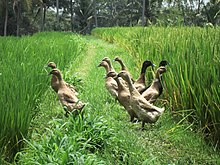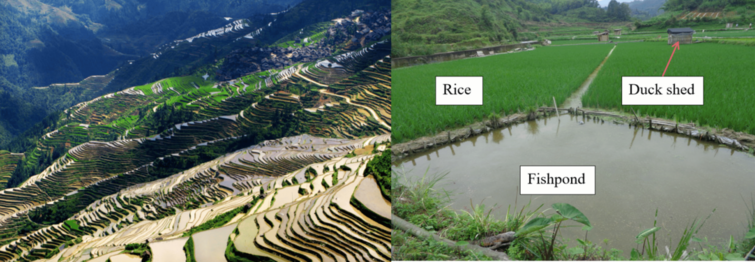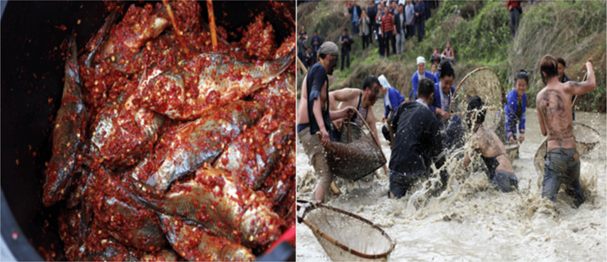Rice polyculture
Rice polyculture is the cultivation of rice and another crop simultaneously on the same land. The practice exploits the mutual benefit between rice and organisms such as fish and ducks: the rice supports pests which serve as food for the fish and ducks, while the animals' excrement serves as fertilizer for the rice. The result is an additional crop, with reduced need for inputs of fertilizer and pesticides. In addition, the reduction of pests such as mosquito larvae and snails may reduce mosquito-borne diseases such as malaria and dengue fever, and snail-born parasites such as the trematodes which cause schistosomiasis. The reduction in chemical inputs may reduce environmental harms caused by their release into the environment. The increased biodiversity may reduce methane emissions from rice fields.
Some rice-animal polycultures, including rice-fish systems in China and rice-duck farming in China and Southeast Asia, have been practised for centuries, while others have been developed more recently. The use of intercropping with plants such as maize and soybean, planted on levees between rice terraces, may help to reduce rice pests such as brown planthopper.
History
[edit]
The simultaneous cultivation of rice and fish is thought to be over 2,000 years old. Ancient clay models of rice fields, containing miniature models of fish such as the common carp, have been found in Han dynasty tombs in China.[2] The system originated somewhere in continental Asia such as in India, Thailand, northern Vietnam and southern China. The practice likely started in China since they were early practitioners of aquaculture.[1]
Rice-duck farming is traditional in Southeast Asia; in China it is sometimes combined with fish on the same terraces.[3]
Mutualism
[edit]
Several animal species have been raised in rice fields, offering the possibility of multiple crops and a variety of ecological and agro-ecological benefits. Pairings such as rice and fish or rice and ducks form a mutualistic relationship: they both benefit from growing together. The rice provides the fish with shelter and shade and a reduced water temperature, along with herbivorous insects and other small animals that feed on the rice.[7] Rice benefits from nitrogenous waste from the fish, while the fish reduce insect pests such as brown planthoppers, diseases such as sheath blight of rice, and weeds.[7] By controlling weeds, competition for nutrients is decreased. CO2 released by the fish may be used in photosynthesis by the rice.[4]
-
Rice-fish-duck system in China - glutinous rice, domesticated carp, Xiaoxiang duck
-
Rice-fish-duck system in China - Congjiang Dong rice terraces - rice paddy, fishpond, duck shed
-
Rice-fish-duck system in China - salted fish - catching fish
With other plants
[edit]Rice is widely grown using periodic flood irrigation, restricting the options for polycultures with other plants. Maize and soybeans are more profitable than rice, and they can be grown on the earth levees between rice terraces. There is some evidence that such intercropping reduces numbers of brown planthopper, a serious pest of rice, though it does not enhance numbers of natural enemies such as parasitoid wasps and insect predators.[8]
One crop that can be grown directly with irrigated rice is water spinach (Ipomoea aquatica, Convolvulaceae family); it is widely consumed as a vegetable in Asia. Experimental intercropping with rice reduced rice diseases and pests: rice sheath blight was cut by 17-50%, while rice leaf folder caterpillars were reduced by 5-58%, and rice yield was increased.[9] Similarly promising experiments have been carried out with pickerelweed.[10]
Taxonomic range
[edit]
As shown in the table, a large number of rice polycultures, with both animals and plants, have been used or studied experimentally.
| Approach | Taxonomy | Location | Notes |
|---|---|---|---|
| Rice-fish | Teleost | China | Ancient system with common carp; from 1935, also other species inc. black carp, grass carp, silver carp, bighead carp[2] |
| Rice-fish | Teleost | Asia | Mozambique tilapia[1] |
| Rice-fish | Teleost | Egypt | Nile tilapia[1] |
| Rice-duck | Bird | China, Malaysia, South Korea, Vietnam, etc. | Surface must be even; water depth must suit ducks; young ducks best as they don't nibble rice leaf tips.[14] |
| Rice-fish-duck | Vertebrates | China | Ancient multiply-mutualistic system[3][12][13] |
| Rice-fish-duck-azolla | Vertebrates, ferns | Indonesia | Azolla (water fern) fixes nitrogen, contributing to plant growth and productivity.[11][15] |
| Rice-crayfish | Arthropod | China | red swamp crayfish, from 1980s[6] |
| Rice-prawn | Arthropod | Indonesia | Freshwater prawn Macrobrachium rosenbergii; may work best at moderate stocking density.[16] Deepwater rice, prawns, and fish: increases rice production.[17] |
| Rice-crab | Arthropod | China | Chinese mitten crab, from 1980s[6] The crabs feed on zooplankton.[18] |
| Rice-turtle | Reptile | China | softshell turtle, from 1980s[6] |
| Rice-maize | Flowering plant | China | Maize on levees may reduce planthopper numbers[8] |
| Rice-soybean | Flowering plant | China | Soybean on levees may reduce planthopper numbers[8] |
| Rice‑water spinach | Flowering plant | China | Successful experiments[9] |
| Rice-pickerelweed | Flowering plant | China | Experimentally reduces sheath blight and leaf folders, and increases rice yield.[10] |
Sustainability
[edit]Rice polycultures offer the potential to help meet multiple sustainability goals in the face of pressures such as population growth and climate change. They may help maintain ecosystem diversity, produce food sustainably with reduced inputs, and adapt to changes in the environment. The inclusion of crops that provide high-quality protein, such as fish, can help to improve people's diet. In addition, environmental impacts from pesticides and fertilizers can be reduced, while for the farmer, the extra crop increases revenue and may also increase rice productivity.[19]
References
[edit]- ^ a b c d Halwart & Gupta 2004, 2. History, pp. 3–4.
- ^ a b Renkui, C.; Dashu, N.; Jianguo, W. (1995). "Rice-fish culture in China: the past, present, and future". In Mackay, Kenneth T. (ed.). Rice-Fish Culture in China. Ottawa, Canada: International Development Research Centre. ISBN 0889367760. Retrieved 12 October 2023.
- ^ a b Zhang, Yin; Guan, Chunyun; Li, Zhengyou; Luo, Jun; Ren, Bo; Chen, Can; Xu, Ying; Ding, Jiaolong; Huang, Huang (19 January 2023). "Review of Rice–Fish–Duck Symbiosis System in China—One of the Globally Important Ingenious Agricultural Heritage Systems (GIAHS)". Sustainability. 15 (3): 1910. doi:10.3390/su15031910. ISSN 2071-1050.
- ^ a b Nayak, P.K.; Nayak, A.K.; Panda, B.B.; Lal, B.; Gautam, P.; Poonam, A.; Shahid, M.; Tripathi, R.; Kumar, U.; Mohapatra, S.D.; Jambhulkar, N.N. (2018). "Ecological mechanism and diversity in rice based integrated farming system". Ecological Indicators. 91: 359–375. Bibcode:2018EcInd..91..359N. doi:10.1016/j.ecolind.2018.04.025. S2CID 90610992.
- ^ Halwart & Gupta 2004, 7.2 Rice Yields, pp. 34–39.
- ^ a b c d e Lu, Jianbo; Li, Xia (2006). "Review of rice–fish-farming systems in China — One of the Globally Important Ingenious Agricultural Heritage Systems (GIAHS)". Aquaculture. 260 (1–4): 106–113. Bibcode:2006Aquac.260..106L. doi:10.1016/j.aquaculture.2006.05.059.
- ^ a b Xie, Jian; Hu, Liangliang; Tang, Jianjun; Wu, Xue; Li, Nana; Yuan, Yongge; Yang, Haishui; Zhang, Jiaen; Luo, Shiming; Chen, Xin (2011). "Ecological mechanisms underlying the sustainability of the agricultural heritage rice–fish coculture system". Proceedings of the National Academy of Sciences. 108 (50): E1381-7. doi:10.1073/pnas.1111043108. PMC 3250190. PMID 22084110.
- ^ a b c Yao, Feng-Luan; You, Min-Sheng; Vasseur, Liette; Yang, Guang; Zheng, Yun-Kai (2012). "Polycultural manipulation for better regulation of planthopper populations in irrigated rice-based ecosystems". Crop Protection. 34: 104–111. Bibcode:2012CrPro..34..104Y. doi:10.1016/j.cropro.2011.12.003.
- ^ a b Ning, Chuanchuan; Qu, Jiahui; He, Liangyu; Yang, Rongshuang; Chen, Quanyang; Luo, Shiming; Cai, Kunzheng (2017). "Improvement of yield, pest control and Si nutrition of rice by rice-water spinach intercropping". Field Crops Research. 208: 34–43. doi:10.1016/j.fcr.2017.04.005.
- ^ a b Xiang, Huimin; Lan, Ni; Wang, Fugang; Zhao, Benliang; Wei, Hui; Zhang, Jiaen (2021). "Reduced pests, improved grain quality and greater total income: benefits of intercropping rice with Pontederia cordata". Journal of the Science of Food and Agriculture. 101 (14): 5907–5917. Bibcode:2021JSFA..101.5907X. doi:10.1002/jsfa.11243. ISSN 0022-5142. PMID 33813747.
- ^ a b Bezemer, Marjolein (23 October 2022). "Mixed farming increases rice yield". reNature Foundation. Archived from the original on 11 October 2019. Retrieved 2 January 2024.
- ^ a b Suh, Jungho (2014). "Theory and reality of integrated rice–duck farming in Asian developing countries: A systematic review and SWOT analysis". Agricultural Systems. 125: 74–81. Bibcode:2014AgSys.125...74S. doi:10.1016/j.agsy.2013.11.003.
- ^ a b Sapcota, D.; Begum, Kashmiri (2022). "Integrated duck farming". Duck Production and Management Strategies. Singapore: Springer Nature. pp. 247–264. doi:10.1007/978-981-16-6100-6_6. ISBN 978-981-16-6099-3. S2CID 246096613.
- ^ Furuno, Takao. Traditional and modern matters on rice cultivation associated with duck. 6th International Rice–Duck Conference. pp. 23–27.
- ^ Cagauan, A. G.; Branckaert, R. D.; Van Hove, C. (2000). "Integrating fish and azolla into rice-duck farming in Asia" (PDF). Naga (ICLARM Quarterly). 23 (1): 4–10.
- ^ Dewi, R. R. S. P. S.; Krettiawan, H.; Anggraeni, F.; Kusnendar, E.; Kusdiarti (1 June 2020). "Productivity and profitability of rice-freshwater prawn culture in different stocking density of prawn". IOP Conference Series: Earth and Environmental Science. 521 (1): 012021. Bibcode:2020E&ES..521a2021D. doi:10.1088/1755-1315/521/1/012021. ISSN 1755-1307.
- ^ Zimmermann, Sergio; New, Michael B. (6 December 2000). "Grow-out Systems - Polyculture and Integrated Culture". Freshwater Prawn Culture. Wiley. pp. 187–202. doi:10.1002/9780470999554.ch12. ISBN 978-0-632-05602-6.
- ^ Guo, Kai; Zhao, Wen; Li, Wenkuan; Zhao, Yuansong; Zhang, Peng; Zhang, Chen (2015). "Food web structure and trophic levels in polyculture rice-crab fields". Chinese Journal of Oceanology and Limnology. 33 (3): 735–740. Bibcode:2015ChJOL..33..735G. doi:10.1007/s00343-015-4205-8. ISSN 0254-4059.
- ^ Freed, Sarah; Barman, Benoy; Dubois, Mark; Flor, Rica Joy; Funge-Smith, Simon; Gregory, Rick; et al. (9 November 2020). "Maintaining Diversity of Integrated Rice and Fish Production Confers Adaptability of Food Systems to Global Change". Frontiers in Sustainable Food Systems. 4. doi:10.3389/fsufs.2020.576179. hdl:1885/267414. ISSN 2571-581X.
Sources
[edit]- Halwart, Matthias; Gupta, Modadugu Vijay (2004). Culture of fish in rice fields. Food and Agriculture Organization and WorldFish Center, Penang, Malaysia. ISBN 983-2346-33-9.



